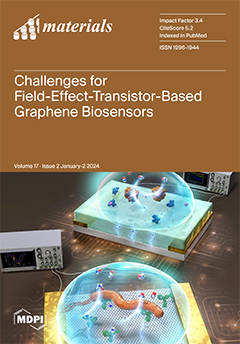Magnetic–plasmonic nanoparticles (NPs) have attracted great interest in many fields because they can exhibit more physical and chemical properties than individual magnetic or plasmonic NPs. In this work, we synthesized Au- or Ag-decorated Fe
3O
4 nanoparticles coated with PEI (Fe
3
[...] Read more.
Magnetic–plasmonic nanoparticles (NPs) have attracted great interest in many fields because they can exhibit more physical and chemical properties than individual magnetic or plasmonic NPs. In this work, we synthesized Au- or Ag-decorated Fe
3O
4 nanoparticles coated with PEI (Fe
3O
4-PEI-M (M = Au or Ag) NPs) using a simple method. The influences of the plasmonic metal NPs’ (Au or Ag) coating density on the magnetic and plasmonic properties of the Fe
3O
4-PEI-M (M = Au or Ag) NPs were investigated, and the density of the plasmonic metal NPs coated on the Fe
3O
4 NPs surfaces could be adjusted by controlling the polyethyleneimine (PEI) concentration. It showed that the Fe
3O
4-PEI-M (M = Au or Ag) NPs exhibited both magnetic and plasmonic properties. When the PEI concentration increased from 5 to 35 mg/mL, the coating density of the Au or Ag NPs on the Fe
3O
4 NPs surfaces increased, the corresponding magnetic intensity became weaker, and the plasmonic intensity was stronger. At the same time, the plasmonic resonance peak of the Fe
3O
4-PEI-M (M = Au or Ag) NPs was red shifted. Therefore, there was an optimal coverage of the plasmonic metal NPs on the Fe
3O
4 NPs surfaces to balance the magnetic and plasmonic properties when the PEI concentration was between 15 and 25 mg/mL. This result can guide the application of the Fe
3O
4-M (M = Au or Ag) NPs in the biomedical field.
Full article






